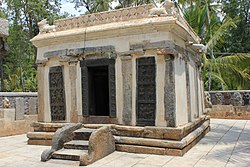Arakeshvara Temple | |
|---|---|
Hindu temple | |
 View of Arakeshvara temple mantapa (10th century A.D.) | |
| Coordinates: 11°58′5.03591″N76°59′15.95497″E / 11.9680655306°N 76.9877652694°E | |
| Country | |
| State | Karnataka |
| District | Chamarajanagar District |
| Languages | |
| • Official | Kannada |
| Time zone | UTC+5:30 (IST) |


The Arakeshvara Temple, dedicated to the Hindu god Shiva, is located in the village of Hole Alur in the Chamarajanagar district of Karnataka state, India. According to the historian Sarma, the temple which dates back to the middle of the 10th century rule of the Western Ganga Dynasty appears to have been renovated in later periods. It was constructed by King Butuga II around 949 A.D. to celebrate his victory over the Cholas of Tanjore in the historically important battle of Takkolam. It was a military engagement between crown prince Rajaditya, son of the Chola King Parantaka I, and King Butaga II (a powerful vassal of the Rashtrakuta emperor Krishna III). [1] [2] [3] [4] [5] The temple is protected as a monument of national importance by the central Archaeological Survey of India. [3] [6]












